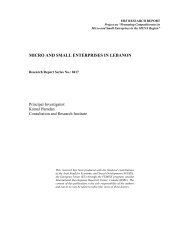Agricultural Productivity and technological gap between MENA ...
Agricultural Productivity and technological gap between MENA ...
Agricultural Productivity and technological gap between MENA ...
Create successful ePaper yourself
Turn your PDF publications into a flip-book with our unique Google optimized e-Paper software.
paper focuses on inter-region comparisons of productivity in agriculture using country-leveldata drawn from the Food <strong>and</strong> Agriculture Organization (FAO) of the United Nations.Countries are grouped into two regions using the geographical classification stated above.1. The Metafrontier approachNumber of authors such as Aigner, Lovell, <strong>and</strong> Schmidt (1977), <strong>and</strong> Meeusen <strong>and</strong> Van derBroeck (1977) developed the “stochastic composed error frontier methodology”. The mainprinciple of the model is to specify the error term as a sum of two parts, one normal <strong>and</strong> theother from a one sided normal distribution 1 .The specification of the stochastic production frontier model, allows for a non-negativer<strong>and</strong>om component in the error term to generate a measure of technical inefficiency or theratio of actual to expected maximum output, given inputs <strong>and</strong> the existing technology. Apartfrom allowing for the measure or assessment of technical inefficiency, stochastic frontiermodels also acknowledge the fact that r<strong>and</strong>om shocks outside the control of producers canaffect the output level. This is due to the fact that stochastic effects such as weather conditionsamong others could cause variations in maximum output. The variations in output could alsooccur as a result of firms in an industry operating at various levels of inefficiency due to poorincentives, mismanagement, inappropriate input levels or less than perfectly competitivebehavior (Kumbhakar <strong>and</strong> Lovell 2000).While technical efficiencies of units that are measured with respect to a given frontier arecomparable, this is not normally the case among units that operate under differenttechnologies. Such problems arise when comparisons of units from different regions areinvolved. The metaproduction function concept is based on the hypothesis that all producersin different groups have potential access to the same technology. However, each producermay choose to operate on a different part of it depending on circumstances such as the naturalendowments, relative prices of inputs, <strong>and</strong> the economic environment (Lau <strong>and</strong> Yotopoulos1989). Recent extensions <strong>and</strong> modification of the stochastic frontier metaproduction functionapproach is found in Battese <strong>and</strong> Rao (2001), which is reviewed below.Let consider that the whole sample is composed of K subsets (K>1) representing K regionsk<strong>and</strong> firms in each region operate under a region specific technology, T (k = 1, 2, …, K).Since all the K’s technology can be considered as a subset of an “over-arching technology”*referred to as the metatechnology, which is represented by T . The metatechnology can be statedas the “absolute best” technology produced by the state of the knowledge. This leadingtechnology is accessible if neither endowments nor policy constraints are facing producers.Battese <strong>and</strong> Rao (2001), showed how technical efficiency scores for firms across regionscan be estimated using a stochastic frontier metaproduction function model, <strong>and</strong> used adecomposition result to present an analysis of regional productivity potential <strong>and</strong> efficiencylevels.If stochastic frontier models are defined for different regions within an industry, <strong>and</strong> forthe kth region, there exist sample data on N kfirms that produce one output from the variousinputs. The stochastic frontier model for this region is specified as 2k vi( k) −ui( k)i(i, β ) , 1,2,...kY = f x e i = N(1)1 or any other probability distribution providing that their support is2 Time subscript is dropped for convenience <strong>and</strong> the logarithmic linear form for the production function isassumed among the paper.+R3
















